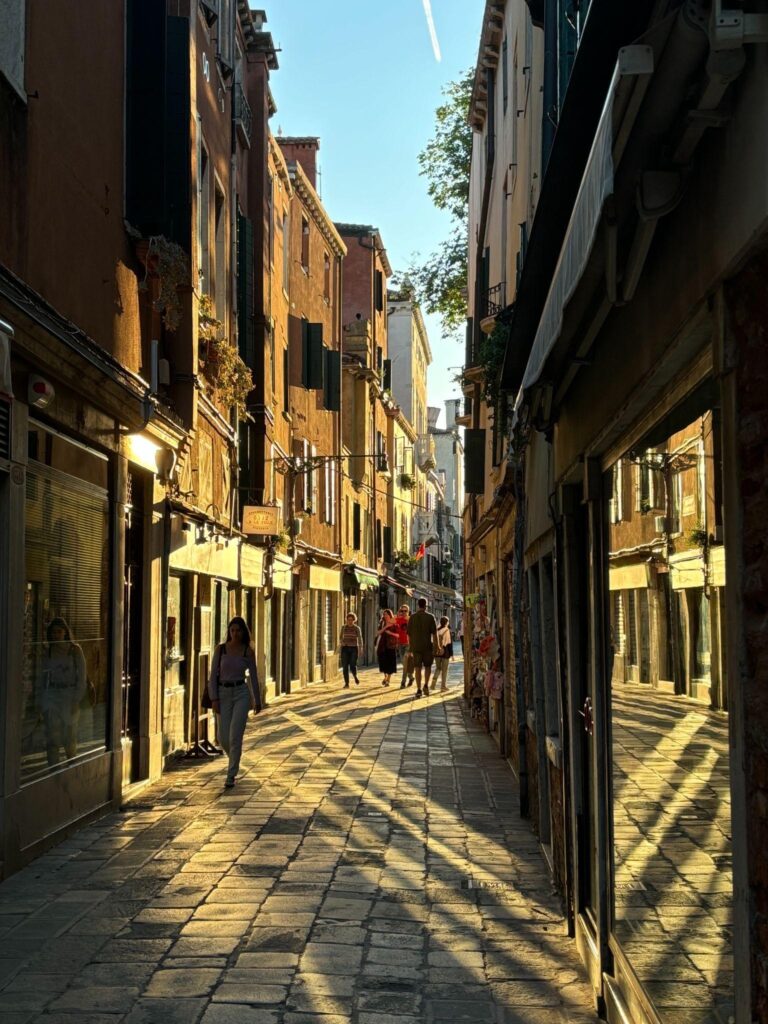Jessica Zhang
Bachelor of Design Majoring in Spatial Design, Auckland University of Technology and Sustainable Healthy Cities: Building for the Future Summer School student
Email: [email protected]
In June 2024, I attended a two-week summer school in Venice, ‘Sustainable, Healthy Cities: Building for the Future’, organised by the GCHU, The Prince’s Foundation, and the European Cultural Academy.
During the course, studying aspects of sustainable urbanism such as food and urbanism, soft mobility, the morphology of sustainable cities, and the history of Venice was rewarding in understanding the city itself and the broader contexts of sustainability and healthy urbanism outside of New Zealand. My personal exploration of Venice has provided valuable insights into sustainability’s social, economic, and cultural dimensions through discussing the various challenges and problems the city currently faces.

Figure 1: Personal Exploration of Venice (SOURCE: THE AUTHOR)
Acquiring a broader understanding of Venice, we were asked to produce an urban design for our given site Tronchetto, an artificial island built in the 1960’s mainly used as a car park for tourists and transportation. Upon the site visit, Venice’s widely held urban imaginaries were strikingly absent, with barren concrete parking lots and mirrored office buildings dominating the island’s identity. Strolling along the empty roads next to cars felt worlds apart from the narrow, lively streets typically associated with Venice.
During my observations of Tronchetto, I wanted to direct my narrative towards the sustainable progression of the site to open a dialogue for Venice’s future. My ethos towards sustainable design centres on my interest in holism in design, leading me to explore problems of severe depopulation caused by tourism in Venice and the lack of green spaces in central Venice. My motivation to focus on these aspects was based on my idea of what makes a city – “What is a city but its people?” – addressing problems of a disconnected community of locals to combat depopulation through redesigning Tronchetto to include more green spaces for the community. Coming from New Zealand, where green spaces are abundant, I was shocked to see the lack of parks and green spaces available for public use – as green third spaces are integral in not only providing spaces for the community, but the addition of plants can absorb carbon and improve air quality.
This vision led me to collaborate with Sarah Hawes, Francesca Coey and Fernanda Samuel Garcia in a group project. “Working across Boundaries” was our strategy for a multi-disciplinary design intervention that sought to address social and environmental issues in Venice through implementing green and blue infrastructure to create ‘social breathing spaces’ that also increase ecological diversity. As a group, we focused on our specialisations and collaborated towards an integrated strategy for Tronchetto. I looked over the implementation of a Community Centre in hopes that it could revitalise the local social economy while ensuring the protection and preservation of environmental and cultural heritage through community involvement. We included additional spaces within the centre, such as a library, artist residence and cafe, to facilitate social interaction, stronger communal bonds and ‘public relaxation’, giving pockets of breathing space away from tourists. Additionally, we implemented a Community Kitchen and Art Gallery that allows locals to be self-determining in choosing whether to interact with tourists through public gallery openings or cooking lessons.

Figure 2: Masterplan of Tronchetto (SOURCE: “Working across Boundaries“)
With the growth of civilisation, drastic changes have followed the environment in response to society’s development to support growing population needs. Including green infrastructure is an essential part of improving liveability and future-proofing a city along with the inclusion of local communities to cultivate a culture of responsibility is crucial for healthy urbanism in cities such as Venice. Going forward from this experience of collaboration, I believe that multidisciplinary approaches in design can create high-quality solutions through the teamwork of experts from different backgrounds to generate a better understanding of complex problems such as the ongoing climate crisis and sustainability issues we face.
